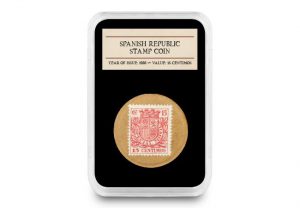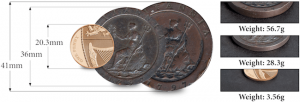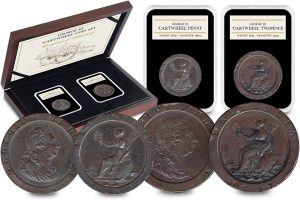Posts Tagged ‘george III coinage’
Imagine using a cup, a stamp, or cardboard as a coin…
Today the coins you find in your change are all produced by the Royal Mint. It’s hard to imagine what life would be like if coins, and the metal to make them, disappeared.
When people have had to go to extreme lengths in the face of emergency, it has produced some of the most intriguing and interesting currencies around. And here are six of the most unusual currencies ever issued, and what drove people to create them.
The coins made from a drinking cup
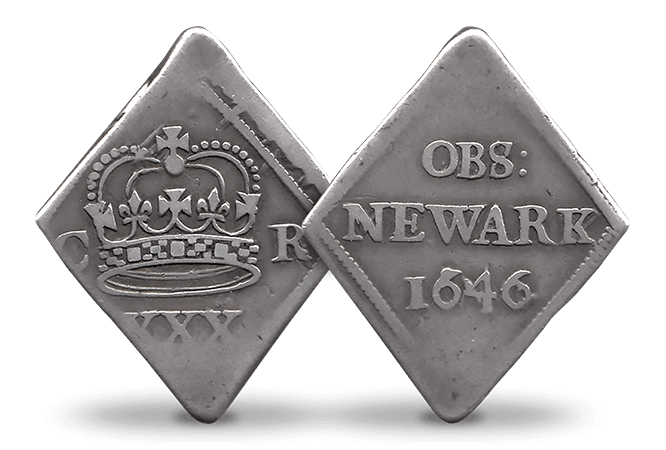
In 1646 in a town under siege, with no incoming money, the people of Newark needed to find a way to pay soldiers for protection. So they reached for whatever metal they had available to make coins – and that meant their cutlery! Silver cups and plates were surrendered, cut up into small diamond shaped pieces, and had a denomination stamped onto them.
Because of the way these coins were made, you could sometimes see the pattern of the cup or plate from which the coins were made. Understandably these coins, which surely belong in a museum, are hugely desirable among collectors and are rarely available.
The notes that were issued to be devalued
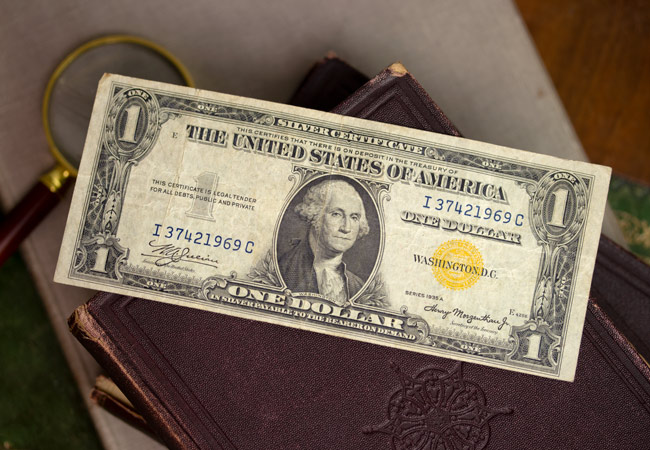
It seems odd that a government would issue money just for it to be devalued. But during WWII when the American army was based in North Africa this is exactly what happened. The American government was concerned that if the Germans were to mount a successful attack, they could take over the currency. Therefore, all notes used to pay soldiers based in North Africa had a yellow seal added to them. This meant that should the Germans take over, the notes could be easily identified by their yellow seal and instantly devalued.
The Russian stamps used as German propaganda
During WW1 the Russian government found it increasingly difficult to issue coins. Instead, they turned to ‘currency stamps’ printed on thin cardboard instead of normal stamp paper. Using stamps instead of coins was a way of saving precious metal for the war effort.
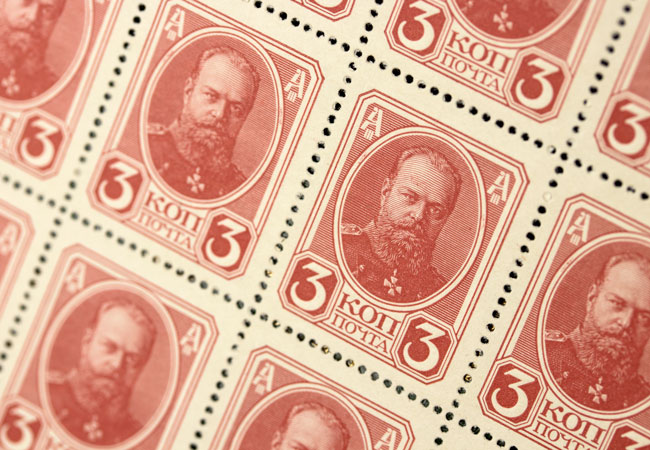
Several denominations of ‘currency’ were issued, with a statement on the reverse stating that each stamp had the circulating equivalent of Silver coins. However some of these stamps soon landed in the hands of Germans who counterfeited them but with one clever detail – the statement on the reverse was changed to an anti-Russian message. The idea was to destroy confidence in the Russian government and devalue the currency.
An unusual English denomination
George III’s reign is known for the vast number of interesting numismatic pieces issued, and the Bank of England emergency tokens are no different. Conflict in George III’s reign had caused financial panic, and thousands of people hoarded silver coins out of fear.
The Royal Mint’s limited ability to issue coins posed a problem as they could not make enough coins for the demand, so eyes turned to the Bank of England. An agreement was made that allowed the Bank to issue emergency currency. However technically speaking these were tokens and not coins, which is why they appear in the unusual denominations such as 1s 6d or 1 Dollar.
Why money was burnt in revolutionary France
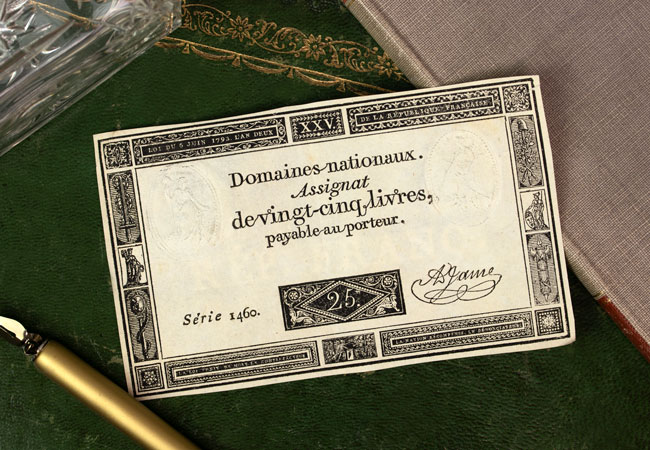
In revolutionary France in the early 1790s, the government issued paper money, known as Assignats, backed by the value of clergy property. The government continued to print money, and faced with an influx of counterfeits from Britain, the value of these Assignats soon reached a massive 45 Billion Livres, despite the value of clergy property only being 3 Billion Livres.
In 1796, the notes had lost all of their value and were publicly burned, to be replaced with a new paper money. Any of these surviving notes are incredibly rare as most of them were destroyed, making them very desirable among collectors.
How a Civil War turned a stamp into currency
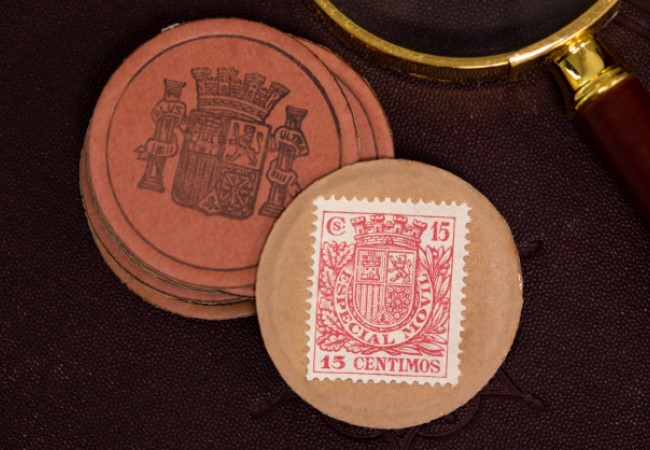
It’s hard to imagine a small paper stamp, issued over 80 years ago, being used to pay for goods and services. But in Spain in 1938 that’s exactly what happened.
The Civil War caused the public to hoard coins out of fear, and so they all but disappeared from circulation. Because metal was in limited supply, the government turned readily available stamps into ‘coins’. Unlike Russian emergency stamp currency, these stamps were welded onto a special board with the coat of arms printed onto the reverse. The stamp value gave these new ‘coins’ a denomination, and they were released into circulation to help towns and cities trade.
With such a delicate nature and small number, it’s no wonder that these coins are scarce and difficult to track down today.
Nowadays the Royal Mint is well suited to meeting our coin demands so it’s unlikely we’ll ever need to use stamps or cutlery in place of coins! Emergency currency is always a fascinating area for collectors, with some of the rarest and most unique issues having appeared out of difficult and troubled times. It’s not often that these emergency issues appear on the market – but it’s certainly worth keeping an eye out for them!
If you’re interested…
Today you can own one of these unusual and fascinating numismatic issues – a Spanish 15 Centimos ‘Coin’. There are only an extremely limited number of these issues available worldwide, and considering the fascinating story behind these issues, our stock is likely to be snapped up fast.
The remarkable story of when a British 2 pence weighed the same as a Mars Bar…
Today I’d like to tell you the story behind my all-time favourite British coins – the Cartwheel Pennies. Not only are they the heaviest and largest coins ever issued for circulation, they were also issued for ONE-YEAR-ONLY. Here’s the story…
Throughout the 18th century silver prices increased, which resulted in a substantial decrease in the amount of silver pennies that were being minted. This led to a lack of small change and businesses were finding it difficult to pay their employees with the current coinage.
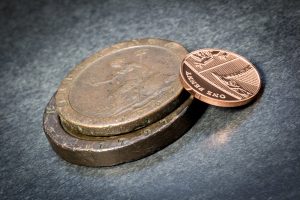
Two of the largest coins ever issued in British history
Subsequently, a trend began where independent Mints started striking copper half penny and penny tokens. Most of these tokens were being minted at the ‘Soho Mint’ in Birmingham, which was actually the very first Mint to be powered by Steam.
Whilst this was not legitimate money it solved the issue and it took off – companies all over Britain were ordering personalised tokens.
However, the ‘solution’ meant there was a problem…
The British Government had lost control of the coinage. In an attempt to regain control, they instructed Soho Mint to strike 480 tonnes of copper pennies and 20 tonnes of copper twopences. These were to be the first regal British coins of the denominations to be made of copper, and the very first official British coins to be struck using steam power.
8 times heavier than today’s 1p and 2p coins
The coins were large! In fact, the 1 pence weighed an incredible 1oz and the 2 pence weighed 2oz – that’s the same weight as a Mars Bar and almost 8 times heavier than the current 1p and 2p coins. At that size, it’s hard to believe these ever jangled in the pocket of our ancestors!
The coins weighed so much becauses they were struck in pure copper and their intrinsic value corresponded to their actual face value. Their design was simple – a portrait of the monarch at the time, King George III on the obverse and Britannia on the reverse.
The dramatic size of these coins and their unusually wide raised rim is why they became known as ‘Cartwheel’ pennies.
Issued for one-year-only
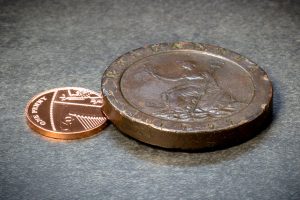
The modern 1p coin compared to the 2oz 2p coin
The ‘Cartwheel’ pennies were designed this way to prevent counterfeiting, but their size and weight made them cumbersome and unwieldy. They were immediately unpopular with the public as people didn’t like carrying them around – the two-pence was an INCH and three-quarters in diameter and a quarter inch thick. There were soon calls for them to be discontinued and shortly after, the coins were redesigned.
Due to the rise in the price of copper, the intrinsic value of the coins soon exceeded their face value and subsequently the majority of these coins were melted down.
This meant, the coins were issued for one-year-only, which automatically makes them two of the must-have modern coins and key coins in any British collection.
If you’re interested…
We have been able to source a small number of sets containing the original 200 year old ‘Cartwheel’ coins – the two pence and the penny. They come presented in a deluxe presentation case with an accompanying Certificate of Authenticity. They really are key must-have coins in any British collection.

